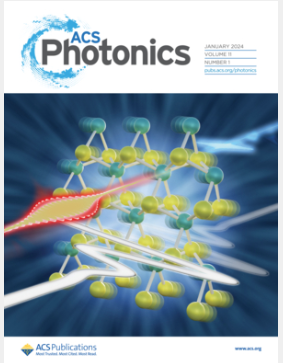Single-Photon Source Monolithically Integrated on a 300 mm Silicon Wafer Using III–V Nano-ridge Engineering
IF 6.5
1区 物理与天体物理
Q1 MATERIALS SCIENCE, MULTIDISCIPLINARY
引用次数: 0
Abstract
Single-photon sources (SPSs) are essential for the development of practical quantum technologies, and their integration with silicon photonics is considered the preferred route for scalable implementations. To fully leverage the mature fabrication processes of CMOS foundries, we investigated the use of nano-ridge engineering (NRE) for the monolithic integration of InAs quantum dot (QD)-based SPSs on 300 mm Si wafers. These nano-ridges are made of high-crystal-quality GaAs selectively grown on a trench-patterned wafer, forming waveguides coplanar to the Si chip. The InAs QDs are embedded in these waveguides to form SPSs. In this work, a new device concept and integration approach is presented, showing that beta factors as high as 0.87 can be achieved owing to the high refractive index contrast between GaAs and SiO2. Then, a first proof of concept is demonstrated. Selective deposition of QDs on top of a diamond-shaped nano-ridge is used to center the dots within the final box-shaped nano-ridge, overgrown after the QD deposition, and to reduce the overall QD density per ridge. The grown QDs showed good spectral properties with line widths as low as 32.7 μeV at 955 nm. The autocorrelation measurements from a selected QD underlines the single-photon nature of the grown structure, with a g2(0) = 0.091 ± 0.005 under nonresonant pulsed excitation. These findings establish a solid foundation for future advancements, including implementing a PIN junction to enhance indistinguishability and extending the emission wavelength to the telecommunication O-band via the growth on InGaAs nano-ridges.

利用III-V纳米脊技术在300 mm硅片上实现单光子源的单片集成
单光子源(SPSs)对于实际量子技术的发展至关重要,它们与硅光子学的集成被认为是可扩展实现的首选途径。为了充分利用CMOS代工厂的成熟制造工艺,我们研究了使用纳米脊工程(NRE)在300 mm Si晶圆上集成基于InAs量子点(QD)的Si晶圆。这些纳米脊是由高晶体质量的砷化镓选择性生长在沟槽图案晶圆上,形成与硅芯片共面波导。将InAs量子点嵌入到这些波导中以形成si。在这项工作中,提出了一种新的器件概念和集成方法,表明由于GaAs和SiO2之间的高折射率对比,可以实现高达0.87的β因子。然后,演示了第一个概念验证。将量子点选择性地沉积在菱形纳米脊上,可以使最终的盒形纳米脊内的点居中,在量子点沉积后会过度生长,并降低每个脊的总体量子点密度。生长的量子点具有良好的光谱特性,在955 nm处线宽低至32.7 μeV。选择的量子点的自相关测量强调了生长结构的单光子性质,在非共振脉冲激励下,g2(0) = 0.091±0.005。这些发现为未来的发展奠定了坚实的基础,包括实现PIN结以增强不可区分性,并通过在InGaAs纳米脊上的生长将发射波长扩展到电信o波段。
本文章由计算机程序翻译,如有差异,请以英文原文为准。
求助全文
约1分钟内获得全文
求助全文
来源期刊

ACS Photonics
NANOSCIENCE & NANOTECHNOLOGY-MATERIALS SCIENCE, MULTIDISCIPLINARY
CiteScore
11.90
自引率
5.70%
发文量
438
审稿时长
2.3 months
期刊介绍:
Published as soon as accepted and summarized in monthly issues, ACS Photonics will publish Research Articles, Letters, Perspectives, and Reviews, to encompass the full scope of published research in this field.
 求助内容:
求助内容: 应助结果提醒方式:
应助结果提醒方式:


